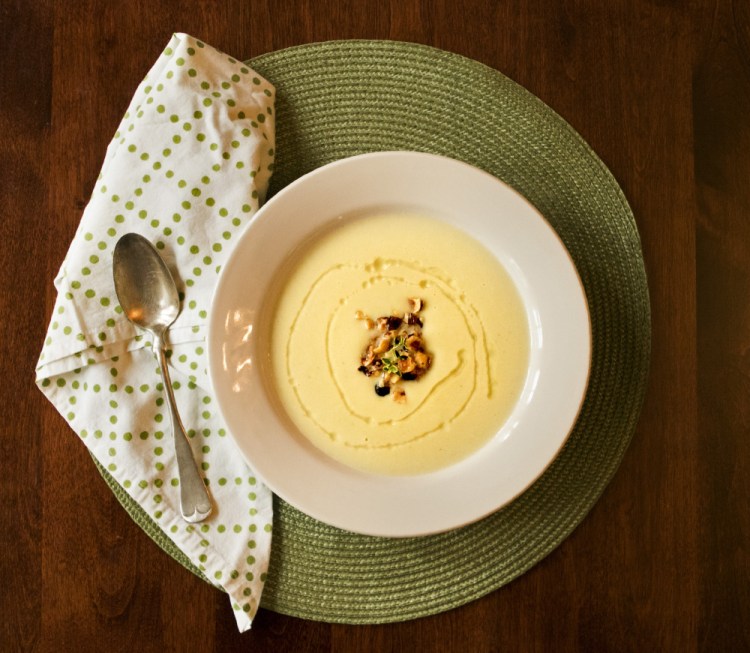The silver lining of a tumultuous presidential election when you’re married to someone who studies fluctuation in United States governmental executive power is that folks around the world want to hear what he has to say about it in an American accent. And sometimes there are enough frequent flier miles for a lucky spouse to tag along.
So please don’t hate me when I say that as this morning’s edition of Source is dropped on your doorstep, I will be strolling the banks of the Rhone River in Lyon, France, perusing the farmers market.
There will be, no doubt, plenty of cardoons there. A heartier cousin of artichokes that resemble big bunches of wild, whiskered celery, cardoons are commonplace in France and Northern Italy, especially around the holidays.
Tim O’Brien, chef at Brunswick’s Enoteca Athena, grew up eating cardoons from his Italian grandmother’s garden in Wells. He says they taste of mushrooms and artichokes with a slight lemony undertone. In years past, he’s served them fried, in a hot spinach and artichoke-like dip, and in a traditional, savory, molded custard called cardoon sformato.
But he’s run out of local sources for this particular nettle even as midcoast Maine has proven itself to be a hospitable environment for cardoons. Cardoons grow as ornamental plants yielding a bristled, purple flower head at the Coastal Maine Botanical Gardens in Boothbay and as part of a recent University of Maine Cooperative Extension Master Gardener demonstration garden at Morris Farm in Wiscasset.
Deborah Chadbourne of Rasmussen Farm and Western Maine Market in Freeman Township likes the idea of enjoying the flavor of artichoke without having to wait for a less hearty artichoke plant to flower. She’s managed to keep onecardoonplant alive for three years in an unheated greenhouse. She adds, though, that the cardoon flowers have always been better sellers than the stalks.
In the past, O’Brien purchased cardoons from Tarbox Farm on Westport Island and then Whatley Farm in Bowdoinham. Whatley Farm manager Ailish Kress said lack of demand led the farm to give up growing them this year.
The fact that they are labor-intensive to grow doesn’t help. To make them tender enough to eat, farmers must employ an agricultural technique called blanching for three to four weeks before harvesting them. This involves tying the stalks together and protecting them from sunlight by wrapping them in newspaper or burlap, like the French do, or bending them backwards and burying them in sand, like the Italians do. (White asparagus is grown according to a similar process – then again, it’s not so popular in the U.S., either.)
I’m not trying to convert you to cardoons – although if you try cookbook author Deborah Madison’s Creamy Cardoon Soup with Thyme and Hazelnuts (see recipe) you might see that particular light. Rather, the point is to push the idea of eater-supported biodiversity.
Biodiversity – the variety of ecological life – is a crucial tenet to greener eating because it provides an array of foods to eat, an assortment of species to carry out environmental services like cleaning water and enriching soil, and an ability for an ecosystem to adjust to disturbances and disease.
Eaters’ role in promoting biodiversity is to seek out a multiplicity of fruits and vegetables that thrive in their local climate.
The farmers I know aren’t making Christmas lists, but rather lists of the crops they’ll be growing in 2017 as they leaf through seed catalogs that arrive sandwiched between L.L. Bean and Lands’ End ones in the mail (although we hope they – and you – have signed up on a Do Not Mail list to avoid getting unwanted catalogs).
Most farmers are happy to talk with eaters about what’s coming down the pike and some even take requests. But if you request a crop, do so with a firm understanding that your fiduciary duty lies in buying it early and often when it finally shows up in the farmers market stall.
Christine Burns Rudalevige is a food writer, a recipe developer and tester and a cooking teacher in Brunswick. Contact her at: cburns1227@gmail.com.
Send questions/comments to the editors.




Success. Please wait for the page to reload. If the page does not reload within 5 seconds, please refresh the page.
Enter your email and password to access comments.
Hi, to comment on stories you must . This profile is in addition to your subscription and website login.
Already have a commenting profile? .
Invalid username/password.
Please check your email to confirm and complete your registration.
Only subscribers are eligible to post comments. Please subscribe or login first for digital access. Here’s why.
Use the form below to reset your password. When you've submitted your account email, we will send an email with a reset code.